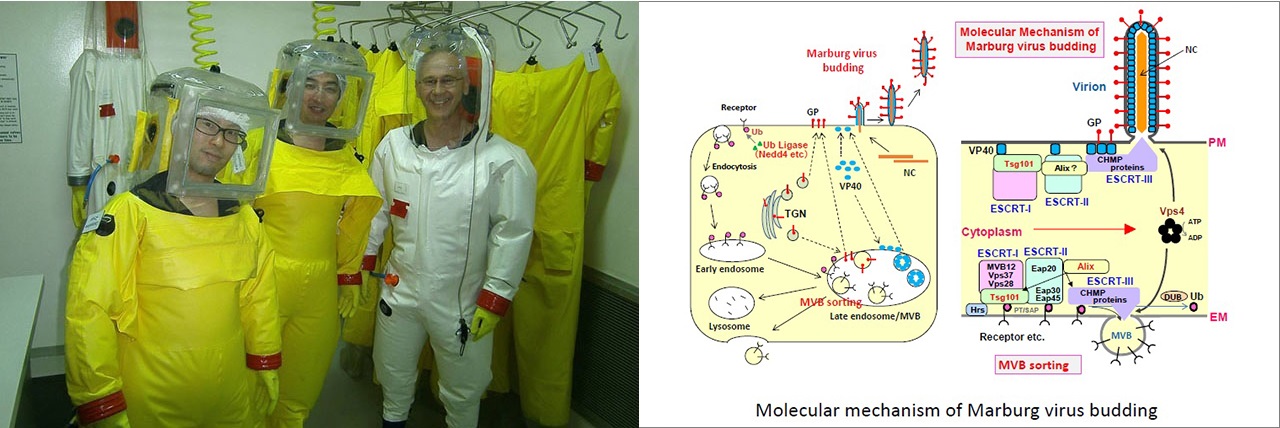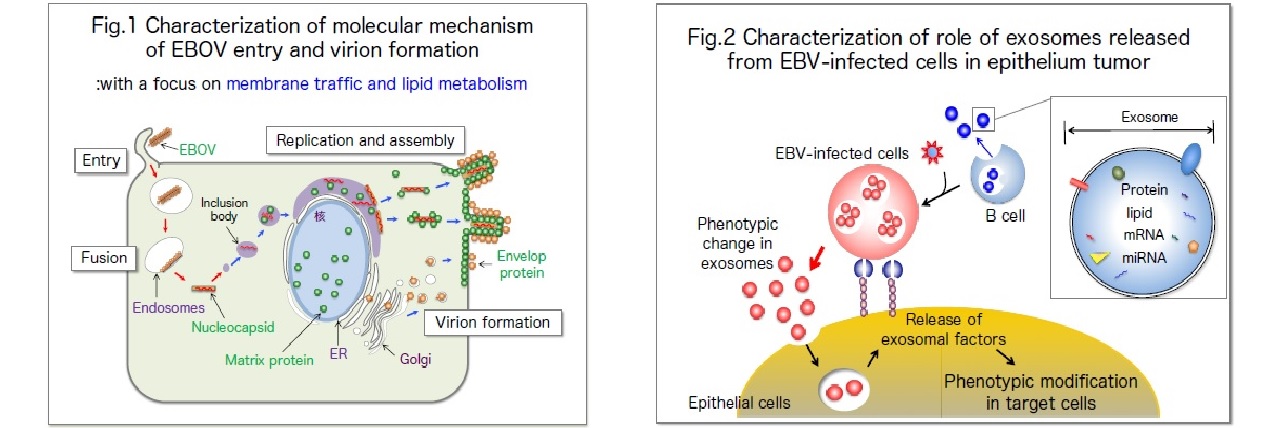Emerging Infectious Diseases

We are working on the basic and applied research to develop the countermeasures against emerging infectious diseases, especially viral hemorrhagic fevers and COVID-19.
Members
- Professor
- Jiro Yasuda
- Professor
- Asuka Nanbo
- Professor
- Kentaro Yoshii
- Associate Professor
- Yohei Kurosaki
- Associate Professor
- Shuzo Urata
- Assistant Professor
- Rokusuke Yoshikawa
- Assistant Professor
- Yasuteru Sakurai
- Assistant Professor
- Takaaki Kinoshita
- Assistant Professor
- Minato Hirano
- Assistant Professor
- Wakako Furuyama
- Assistant Professor
- Misako Yajima
- Research Fellow
- Sayaka Okada
- Research Fellow
- Mayuko Kimura
- Research Fellow
- Christelle Pemba Mawonga
- Assistant
- Miku Takano
- Graduate student
- Patrick Mpingabo Ilunga
- Graduate student
- Ryosuke Yamashiro
Activities
Analyses of replication mechanisms of highly pathogenic viruses
In infected cells, the viruses replicate using various cellular machinery and release a large number of progeny virions. Our interests are to clarify the molecular mechanisms of virus replication in host cells. We are currently analyzing the molecular interactions between viral proteins and cellular factors in infected cells. Especially, we are focusing on highly pathogenic viruses, such as Ebola virus, Marburg virus, Lassa virus and SARS-CoV-2.
Development of novel antiviral strategies
To establish novel antiviral strategies against viral hemorrhagic fevers and COVID-19, we are identifying the cellular factors which have antiviral activity and analyzing the molecular mechanisms of their antiviral action. We are also doing high-throughput screening of organic and chemical compound libraries for antiviral drug discovery against viral hemorrhagic fevers and COVID-19.
Development of detection methods for highly pathogenic viruses
In case of outbreak of emerging infectious diseases, rapid and accurate diagnoses are essential to control infection and to prevent further transmission. We have developed novel diagnostic assays for emerging viral diseases.
Research studies on viral diseases in Gabon republic
The followings are aims of this project; 1) to investigate prevalence of known and unidentified viral diseases in Gabon through genetical and serological assays, 2) to determine characteristics including genetic information and pathogenicity of viruses which are regarded as public health concern and those newly identified in Gabon, and 3) to develop rapid diagnostic methods for viral diseases of public health concern and/or those newly identified.
Field studies on emerging viral diseases and zoonoses
To understand the ecology of the viruses which may cause emerging viral diseases, we are capturing wild animals including bats, primates and rodents and collecting the samples in Gabon and Thailand. We are currently identifying the viruses which may be transmitted to human and analyzing their characteristics.
Recent main research achievement
- Urata et al. J Virol 2023; 97(3): e0001523.
- Yoshikawa et al. J Biol Chem 2023; 299(6): 104819.
- Abe et al. Microorganisms 2023; 11(8): 2046.
- Kawasaki et al. Sci Rep 2023; 13(1): 13105.
- Amano et al. Viruses 2023; 15(10): 2086.
Achievement list

Ebola virus(EBOV) and Epstein-Barr virus(EBV) both cause major infectious diseases in humans, such as Ebola virus disease(EVD) and EBV-associated malignancies, respectively. The long-term goal of our study is to provide insights into the molecular mechanisms of their pathogenesis, which shall lead to the development of rational therapies and diagnosis for them.
Activities
- Characterization of molecular mechanisms of EBOV entry and virus particle formation: toward the development of novel therapeutics for EVD
EBOV, a member of the family Filoviridae, is an enveloped, single-stranded, negative-sense RNA virus that causes severe hemorrhagic fever with a high mortality rate, known as EVD, in humans and nonhuman primates. Currently, only a few therapeutics has been approved for treatment and prevention of EVD.
Because of the likelihood of future outbreaks and generation of mutant viruses, the development of a variety of EBOV therapeutics is urgent. Our goal is to elucidate the mechanism underlying virus entry and viral particle formation processes with a focus on host membrane traffic dynamics and viral envelope’s constituent phospholipids. We are also developing the therapeutics that specifically target the entry and viral particle formation process in multiple ways, which should lead to the significant contribution for prevention of EVD in the future. - Characterization of molecular mechanism of development of EBV-associated epithelium tumors
EBV, a ubiquitous human γ-herpesvirus, establishes a persistent latent infection in Blymphocytes and epithelial cells in more than 90% of adults worldwide. Although this virus contributes causally to lymphomas and epithelial malignancies such as Burkitt’s lymphoma, gastric carcinoma, and nasopharyngeal carcinoma, the molecular mechanism by which EBV cause these tumors remains fully elucidated. To update the understanding of the mechanisms for development of EBV-associated epithelial tumors, we are elucidating the physiological significance of exosomes, one type of extracellular vesicles, released from EBV-infected cells in tumor development. Moreover, we try to identify host and viral factors including micro RNAs that are specifically and abundantly incorporated in exosomes, which shall lead to the development of potential biomarkers for EBV-associated tumors that contribute to the diagnosis of these tumors.
Recent main research achievement
- Sasaki et al. Biochem Biophys Rep 2024; 38: 101712.
- Nanbo et al. Microorganism 2024; 12(4): 806.
- Wannigama et al. Lancet Infect Dis 2024; S1473-3099(24)00155-5.
- Wannigama et al. Lancet Infect Dis 2023; S1473-3099(23)00620-5.
- Dochi et al. Int J Cancer 2023; 154(5): 895.
Achievement list
Flavivirus and Orthonairovirus include important pathogens which cause severe disease in human and animals, and many of the mare transmitted by arthropod vectors in nature. We conduct research on the ecology of these viruses in hosts and environment to control infectious disease caused by these viruses.
Activities
- Research on mechanisms of virus infection and adaptation in hosts
Arthropod-borne viruses are maintained in the transmission cycle between arthropod(ticks and mosquitos) and vertebrate (mammals and birds) crossing species barrier. Although Each host has various anti-viral mechanisms, the viruses evolved to replicate in their hosts by a daptation to evade the mechanisms. We have studied the virus replication and adaptation mechanisms in terms of virus-host interactions. - Research on virus epidemiology and development of diagnostics
High-containment biological laboratories are required to handle highly pathogenic viruses, such as tick-borne encephalitis virus, West Nile virus and Crimean-Congo hemorrhagic fever virus. It causes difficulties for the research institute to conduct research on these viruses. We have developed safe substitute such as virus-like particle system for live viruses by molecular technology and applied them to new and safe diagnostics. By using these diagnostics, we have constructed frameworks and have conducted surveys to reveal the virus epidemiology inside and outside Japan.
Recent main research achievement
- Hirano et al. Antiviral Res 2022;200:105276.
- Takahashi et al. Ticks Tick Borne Dis 2022;13:101900.
- Kodama et al. Nat Commun 2022;12:5539.
- Maezono et al. Sci Rep 2022;11:9213.
- Haviernik et al. Antiviral Res 2021;185:104968.
